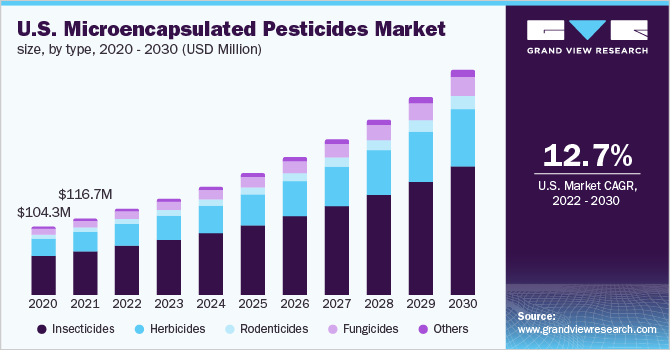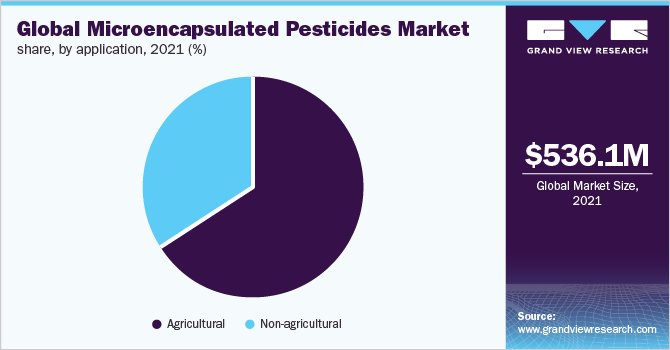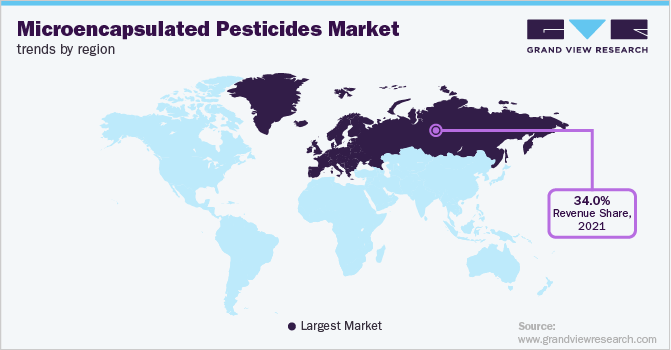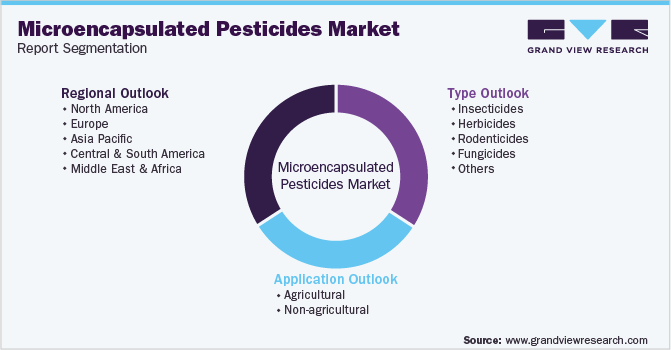- Home
- »
- Agrochemicals & Fertilizers
- »
-
Microencapsulated Pesticides Market Share Report, 2030GVR Report cover
![Microencapsulated Pesticides Market Size, Share & Trends Report]()
Microencapsulated Pesticides Market Size, Share & Trends Analysis Report By Type (Insecticides, Herbicides), By Application (Agriculture, Non-agriculture), By Region, And Segment Forecasts, 2022 - 2030
- Report ID: GVR-4-68040-002-6
- Number of Report Pages: 80
- Format: PDF, Horizon Databook
- Historical Range: 2018 - 2020
- Forecast Period: 2022 - 2030
- Industry: Bulk Chemicals
Report Overview
The global microencapsulated pesticides market size was at USD 536.1 million in 2021 and is expected to witness a compound annual growth rate (CAGR) of 12.7% from 2022 to 2030. The increasing application of microencapsulated pesticides in the agricultural field for controlling various disease carriers and pests is a key factor driving the growth of the market. This pesticide also controls insect infestation, weeds, mosquitoes, mice, rats, and more. Growing utilization of microencapsulated pesticides in agricultural application is anticipated to be the key driver for the growth of the market over the forthcoming years.

Microencapsulated pesticides are small capsules with a diameter of 1-1000 μm filled with liquid, solid, or gas materials that have been extensively utilized in agricultural application and non-agricultural applications such as forestry, ornamental and turf, structural and more. The pesticide capsules are blended with water and sprayed over crops. The capsule’s wall, made with a polymer shell, dissolves in water and slowly releases the pesticide. This is a gradual process of releasing pesticides in water which also controls its loss. Microencapsulated capsules provide a range of benefits such as protection of crops from insect attack, covert liquid into solids, reactive compound separation, and more.
Insecticides are highly consumed microencapsulated pesticides owing to their ability to reduce the effects of insects by killing them or preventing them from engaging in destructive behavior. Insecticides are formulated to kill, mitigate or reduce the risk of insect attack on crops. Insecticides work in a variety of ways where some insecticides may damage the nerve systems, whereas others may disrupt their exoskeletons. The rising consumption of insecticides in the agricultural application is expected to contribute to the growth of the market in the coming years.
Microencapsulated pesticides are widely used in agricultural as well as non-agricultural applications. In agriculture, these pesticides are used for preventing insects from damaging the crop. These pesticides are widely consumed by farmers for the security and safety of their crops. Growing agricultural activities on the account of rising consumption of food are likely to escalate the demand for microencapsulated pesticides over the projected years. The non-agricultural application includes the utilization of pesticides in livestock, residential & commercial, food processing, and public health settings. The growing need for pesticides in the easiest and safest form available is likely to elevate the growth of the market.
The government has been taking several initiatives to mitigate the harm caused by pesticides to humans and the environment. Pesticides are a mixture of chemicals that may be harmful to humans and the environment and cause multiple issues. Therefore, the government bodies of different countries have imposed several regulations on its consumption, transportation, and storage.
Type Insights
Insecticides dominated the market with the highest revenue share of around 55% in 2021. Its high share is driven by its rising consumption for killing the insects that may harm the crops in the agricultural field. Insecticides are treated as the most viable option for farmers for keeping their crops safe from the attack of insects. Growing agricultural operations coupled with the low price of insecticides is likely to contribute to the growth of the market over the forecasted years.
Herbicides are another type of microencapsulated pesticides that is likely to record significant growth over the projected years. The growth is attributed to the rising consumption of herbicides as weed-killers and for the reduction of unwanted vegetation. Herbicides are effective in killing weeds by protecting crops from harm. The growing need for herbicides in agricultural, forestry, and gardening application is expected to bolster its demand in the future years.
Fungicides are heavily utilized in agricultural and gardening applications to prevent fungi to destroy crops or plants. Fungi are fatal to agriculture and cause serious damage to crops, which may result in loss of yield, profit, and quality. To mitigate the effects of fungi, fungicides are extensively used in agricultural application. The growing need to protect crops from fungi is expected to augment the demand for fungicides over the projected years.
Application Insights
Agricultural application dominated the market with the highest revenue share of around 65% in 2021. Its high share is attributable to the rising demand for food across the globe. Food has been the primary necessity of humans. The growing global population has been escalating the consumption of food over the past few years. Growing food consumption has led to an increase in food production, which has fueled agricultural activities across the globe.

Microencapsulated pesticides play a major role in the agricultural field to protect crops from unwanted vegetation, insects, fungi, and more. Growing demand for food is anticipated to contribute to the growth of the market over the forthcoming years. Non-agricultural application of microencapsulated pesticides includes livestock, residential & commercial, and food processing.
Regional Insights
Europe dominated the microencapsulated pesticides market with the highest revenue share of around 34.0% in 2021. This is attributed to the increasing agricultural production across European countries. The growing population and rising consumption of food have been the key factor behind the growth of the market in Europe. Europe is the key producer of wheat, rice, maize, potatoes, soybeans, and others. Growing agricultural activities is likely to escalate the demand for microencapsulated pesticides in Europe over the future years.
North America is among the largest agricultural producers and consumers of pesticides. The U.S. is the key exporter of food on the account of growing agricultural sector in the country. According to the U.S. Department of Agriculture (UDA), food, agriculture, and related industries contributed USD 1.06 trillion to the Gross Domestic Product (GDP) of the U.S. Growing food and agricultural market in the U.S. is expected to propel the demand for microencapsulated pesticides in the country. According to Environment Health (EH), the U.S. along with European Union (EU), Brazil, and China have been taking several initiatives to ban pesticides that are harmful to the environment. This factor is expected to create lucrative opportunities for microencapsulated pesticides in North America.

Asia Pacific is the most populous region across the globe. According to United Nations Fund for Population Activities (UNFPA), Asia Pacific accounts for 60% of the total global population with 4.3 billion people. The growing population has been the key reason for the increasing demand for food in the region, as a result, has been propelling agricultural activities in the region. Farmers rely heavily on pesticides to protect their crops from the attack of insects. However, pesticides are considered harmful to the environment due to their hazardous nature, whereas, microencapsulated pesticides provide a little extra safety due to their polymer cover, thus, it is highly consumed in the Asia Pacific, and are likely to record positive growth in the future.
Key Companies & Market Share Insights
Key market players are inclined towards making a large investment for the expansion of production facilities and new product development. Rapid research & development activities have been propelling innovation in product design and quality assurance. The high demand for microencapsulated pesticides from the agricultural industry has created a highly competitive environment for its manufacturers, which is likely to act as a barrier for new entrants. Some of the prominent players in the global microencapsulation pesticides market include:
-
Bayer AG
-
BASF SE
-
ADAMA Agricultural Solutions Ltd.
-
FMC Corporation
-
Syngenta
-
Yara International
-
Sumitomo Chemicals
-
Israel Chemical Company
-
Arysta LifeScience
-
Nufarm Limited
-
GAT Microencapsulation
-
Botanocap
-
K + S Group
Microencapsulated Pesticides Market Report Scope
Report Attribute
Details
Market size value in 2021
USD 601.4 million
Revenue forecast in 2030
USD 1,569.9 million
Growth rate
CAGR of 12.7% from 2022 to 2030
Base year for estimation
2021
Historical data
2018 - 2020
Forecast period
2022 - 2030
Quantitative units
Volume in Kilotons, revenue in USD million, and CAGR from 2022 to 2030
Report coverage
Revenue forecast, company ranking, competitive landscape, growth factors, and trends
Segments covered
Type, application, region
Regional scope
North America; Europe; Asia Pacific; Central & South America; Middle East & Africa
Country scope
U.S.; Canada; Mexico; Germany; U.K.; France; Italy; Spain; Netherlands; Russia; Turkey; China; India; Japan; Australia; Thailand; Indonesia; Brazil; Argentina; Colombia; Saudi Arabia; Iran; South Africa; Nigeria
Key companies profiled
Bayer AG; BASF SE; ADAMA Agricultural Solutions Ltd.; FMC Corporation; Syngenta; Yara International; Sumitomo Chemicals; Israel Chemical Company; Arysta LifeScience; Nufarm Limited; GAT Microencapsulation; Botanocap; K + S Group
Customization scope
Free report customization (equivalent up to 8 analysts working days) with purchase. Addition or alteration to country, regional, and segment scope.
Pricing and purchase options
Avail customized purchase options to meet your exact research needs. Explore purchase options
Global Microencapsulated Pesticides Market Segmentation
This report forecasts revenue growth at global, regional, and country levels and provides an analysis of the latest industry trends in each of the sub-segments from 2018 to 2030. For this study, Grand View Research has segmented the global microencapsulated pesticides market report based on type, application, and region:

-
Type Outlook (Volume, Kilotons; Revenue, USD Million, 2018 - 2030)
-
Insecticides
-
Herbicides
-
Rodenticides
-
Fungicides
-
Others
-
-
Application Outlook (Volume, Kilotons; Revenue, USD Million, 2018 - 2030)
-
Agricultural
-
Non-agricultural
-
-
Regional Outlook (Volume, Kilotons; Revenue, USD Million, 2018 - 2030)
-
North America
-
U.S.
-
Canada
-
Mexico
-
-
Europe
-
Germany
-
U.K.
-
France
-
Italy
-
Spain
-
Netherlands
-
Russia
-
Turkey
-
-
Asia Pacific
-
China
-
India
-
Japan
-
Australia
-
Thailand
-
Indonesia
-
-
Central & South America
-
Brazil
-
Argentina
-
Colombia
-
-
Middle East & Africa
-
Saudi Arabia
-
Iran
-
South Africa
-
Nigeria
-
-
Frequently Asked Questions About This Report
b. The global microencapsulated pesticides market size was valued at USD 536.1 million in 2021 and is expected to reach USD 601.4 million in 2022.
b. The global microencapsulated pesticides market is expected to grow at a compound annual growth rate (CAGR) of 12.7% from 2022 to 2030 to reach USD 1,569.9 million by 2030.
b. Insecticides dominated the market with the highest revenue share of around 55% in 2021. Its high share is driven by its rising consumption for killing the insects that may harm the crops in agricultural field.
b. Some prominent players in the global Microencapsulation Pesticides market comprise of: • Bayer AG • BASF SE • ADAMA Agricultural Solutions Ltd. • FMC Corporation • Syngenta
b. The increasing application of microencapsulated pesticides in agricultural field for controlling various disease carriers and pests is a key factor for the growth of the market.
Share this report with your colleague or friend.
![gvr icn]()
NEED A CUSTOM REPORT?
We can customize every report - free of charge - including purchasing stand-alone sections or country-level reports, as well as offer affordable discounts for start-ups & universities. Contact us now
![Certified Icon]()
We are GDPR and CCPA compliant! Your transaction & personal information is safe and secure. For more details, please read our privacy policy.
We are committed towards customer satisfaction, and quality service.
"The quality of research they have done for us has been excellent."





